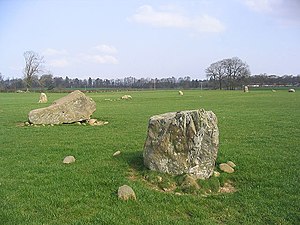Holywood, Dumfriesshire: Difference between revisions
Created page with "thumb|The Twelve Apostles stone circle '''Holywood''' is a village and parish in Dumfriesshire. The vi..." |
|||
| Line 12: | Line 12: | ||
==References== | ==References== | ||
{{reflist}} | {{reflist}} | ||
[[Category:Towns and villages in Dumfriesshire]] | |||
Latest revision as of 09:49, 25 October 2015

Holywood is a village and parish in Dumfriesshire. The village of Holywood was developed in the mid twentieth century.[1] In 1949 eighteen houses were built by the county council and followed shortly after by another 38.[2]
Holywood was the site of a Premonstratensian abbey which was established in 1225 and dissolved in 1609.[3][4] The abbey was dismantled and used to build the parish church in 1778.[3] No remains are now visible.[3]
The site of Holywood abbey was previously called Dercongal, 'Congal's oak-copse'.[5] The name Holywood refers to this oak-copse.[5] The saint commemorated in this name may be Convallus, disciple of Saint Mungo.[5] However, there are a number of other saints to whom the dedication could apply.[6] The surrounding landscape has several prehistoric monuments, including two cursuses and the Twelve Apostles stone circle,[7] which suggests a continuity of sacred or administrative tradition in the area.[8]
The parish previously had three schools: Speddoch, Steilston and Holywood, near the village.[9] The current school building was built in 1967.[1] Its catchment includes the Woodlands area of Dumfries and part of the catchment of Auldgirth Primary School, which closed in 2000.[10]
Holywood railway station opened as Killylung in 1849 but was renamed Holywood within a year and closed in 1949.
References
- ↑ 1.0 1.1 Gifford, John (2002). Dumfries and Galloway. Pevsner Architectural Guides: The Buildings of Scotland. New Haven and London: Yale University Press. pp. 348. ISBN 9780300096712.
- ↑ Duncan, Walter (1962). "Chapter 13: The Parish of Holywood". in Reid, W. Arnold. The County of Dumfries. The Third Statistical Account of Scotland. 12. Glasgow: Collins. pp. 151.
- ↑ 3.0 3.1 3.2 "Canmore: Holywood Abbey". Archived from the original on 2015-05-17. http://web.archive.org/web/20150517092617/http://canmore.rcahms.gov.uk/en/site/65500/details/holywood+abbey/&biblio=more. Retrieved 2015-05-17.
- ↑ Crowe, Chris (2002). "Holywood, an Early Mediaeval Monastery: Problems and Possibilities". Transactions of the Dumfriesshire and Galloway Natural History and Antiquarian Society. Third Series LXXVI: 113. SSN 0141-1292. http://www.dgnhas.org.uk/transonline/SerIII-Vol76.pdf#page=118.
- ↑ 5.0 5.1 5.2 Watson, W. J. (1926). The Celtic Place-Names of Scotland. Edinburgh and London. pp. 169. http://www.spns.org.uk/watsdg.html.
- ↑ "HOLYWOOD ABBEY, AKA DERCONGAL, HOLYWOOD". Archived from the original on 2015-04-12. http://web.archive.org/web/20150412074214/http://saintsplaces.gla.ac.uk/place.php?id=1359992799. Retrieved 2015-05-17.
- ↑ Burl, Aubrey (2005). A Guide to the Stone Circles of Britain, Ireland and Brittany. New Haven; London: Yale University Press. pp. 124.
- ↑ Crowe, Chris (2002). "Holywood, an Early Mediaeval Monastery: Problems and Possibilities". Transactions of the Dumfriesshire and Galloway Natural History and Antiquarian Society. Third Series LXXVI: 114. SSN 0141-1292. http://www.dgnhas.org.uk/transonline/SerIII-Vol76.pdf#page=118.
- ↑ Duncan, Walter (1962). "Chapter 13: The Parish of Holywood". in Reid, W. Arnold. The County of Dumfries. The Third Statistical Account of Scotland. 12. Glasgow: Collins. pp. 152.
- ↑ "Holywood Primary School". Archived from the original on 2015-05-17. http://web.archive.org/web/20150517150531/http://www.dumgal.gov.uk/index.aspx?articleid=1462&contactid=4241. Retrieved 2015-05-17.